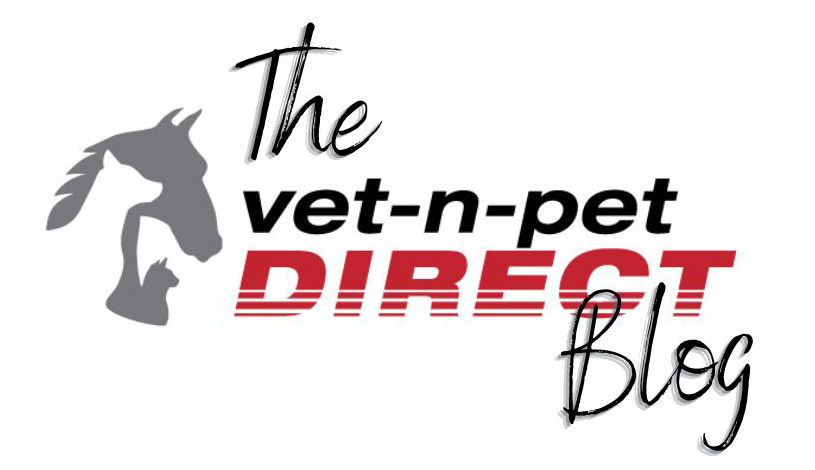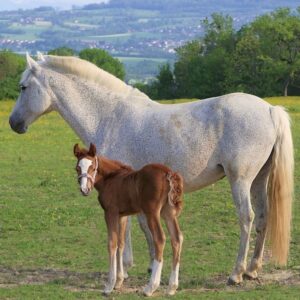It’s that time of the year again, foaling and breeding season! It is the most exciting time of year for horse breeders, as well as the busiest and most exhausting.
Over the years I have found myself explaining to horse owners the steps and procedures involved in breeding a mare. I know it can be hard to remember the meaning of all terms you hear or see on a veterinary bill. So whether you’re a first-time breeder, an owner, or work with horses this might help.
Here are some common horse breeding terms that you might hear or use during the season.
Dam
– the mother of a horse.Sire
– the father of a horse.Waxed Up
– describes when a mare develops droplets of colostrum on her teats that look like beads of wax. This can occur when foaling is imminent or even as early as two weeks before foaling. Not all mares will “wax up”IgG
– stands for Immunoglobulin Type G or sometimes called Gamma Globulin G. An IgG Test or a Gamma E Check Test involves taking a blood sample from the foal at 12-16 hours of age. This is used to determine if the foal has received and absorbed enough of the important antibodies that are passed through the mare’s colostrum.Flush
– a uterine flush is usually performed on a mare after foaling if she has a uterine infection or sometimes after breeding. It involves a vet feeding a catheter (long thin tube) through the vulva to the uterus and then putting liquid through it and into the uterus. A flush can be done with water or saline and it can be mixed with iodine or antibiotics if there is an infection present.Scan
– scans look at the ovaries and follicle size to determine what stage of the reproductive cycle a mare is in. It is done using an ultrasound that is guided through the rectum to examine the mare’s reproductive organs. Scans are also performed to determine and monitor pregnancy.Follicle Test (FT)
– Follicle Tests are the most accurate way to determine when a mare will be ready to breed. A vet will use an ultrasound to scan the follicles to see what size they are. This helps determine when the mare will be ready to ovulate and the best time to breed the mare.Corpus Luteum (CL)
– a structure that develops in the ovary after ovulation. It produces progesterone and oestrogen which are hormones necessary to support pregnancy. If pregnancy does not occur the CL will regress within a few days. If pregnancy does occur it will remain for a few months and continue to produce hormones to support the pregnancy.Oxy (Oxytocin)
– a medication given to the mare to make the smooth muscle tissues of the uterus contract which then helps rid the uterus of any fluid. It is often given post foaling, after a flush and sometimes after breeding.PG
– short for Prostaglandin. PG is a hormonal injection given to mares to help bring them into heat as quickly as possible. Prostaglandin also causes luteolysis (the regression of the corpus luteum) which then helps to shorten the luteal stage and shorten the cycle.Swabs
– mares may require a clitorial and/or uterine swab to ensure that no infection is present before breeding or to determine if or what infection is present. A simple swab is taken of the area and it is then sent away to a laboratory for testing.Caslicks
– a procedure that involves stitching closed the upper part of the mare’s vulva. Caslicks are performed to help prevent reproductive system infections that can occur due to a mares poor conformation, previous foaling injuries, or from sucking air through the vulva. Caslicks should be removed prior to foaling or serving to prevent the vulva from being torn or damaged.Serve
– the process of mating a mare to a stallion.AI
– short for Artificial Insemination. AI is when a mare is inseminated with semen that has been collected from a stallion. The semen can be used fresh, chilled or frozen and is inseminated into the uterus when the mare is ready to breed.I hope this helps you to understand some of the common horse breeding terms and procedures. If you have any questions or concerns about your horse or breeding you should speak to your veterinarian.
Until next time,
Bec


More important than the percentage of mares who conceive on foal heat is percentage of live foals from foal heat breeding, which I think is only around 35%. Has this statistic changed? From my perspective, foal heat breeding is a poor practice when using no-guarantee frozen semen.
Hi Wasim,
Thank you for your comment. I don’t disagree with you, foal heat (in my opinion) is not the most optimal time to breed a mare, however every situation, mare and breeding program is different. I am not aware of the statistics on live foals from mares bred in foal heat. I imagine it is a hard statistic to measure as there are a number of other factors influencing this and it probably varies in different breeds, breeding circumstances and industry’s. Perhaps I will look into the statistics in a future blog.
Kind Regards
Rebecca